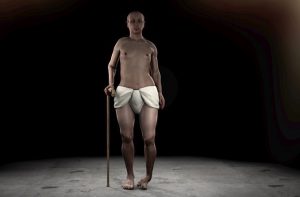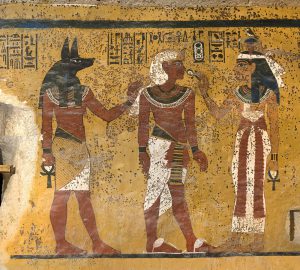Since Howard Carter unveiled the tomb of the ancient Egyptian Pharaoh Tutankhamen in 1922, the world has been fascinated with the king. One major question surrounding Tut is the circumstance of his sudden death. Using bioarchaeology, archaeologists may have found a conclusive answer.
From examining Tut’s body along with written records, it’s evident that Tut died around 19 years old and his burial was rushed and unexpected. The tomb is small for a pharaoh, so Egyptologists speculate that it wasn’t originally intended for Tut, but they needed to bury him quickly (more on this that may lead to new discoveries in the link at the bottom). Bioarchaeology confirms Tut’s hurried burial. Mold-like spots appear on the tomb walls, and comparison of old and new photographs prove they haven’t changed since 1922, suggesting the spots are ancient. Recent microbial analysis confirms this by showing that the spots contain melanins, a sign of the metabolism of fungus, but no living microbes were found. The environment of the walls’ wet paint combined with foodstuffs buried with Tut would’ve created the perfect environment for microbial growth, resulting in the spots.
What could be the reason for Tutankhamen’s early and unexpected demise? Many have speculated about murder, a chariot accident, and even an unfortunate hippopotamus encounter. However, the bioarchaeology tells a much less dramatic story. Previously, the chariot accident was the leading theory on Tut’s death, as some chariots were buried with him and according to his mummy’s early CT scans, he suffered a fatal blow to the head. Bioarchaeologists debunked this theory when they determined Tut’s head injury was post-mortem (after death), probably sustained either in the mummification process or the mishandling of the body by Carter’s team. Also, bioarchaeology reveals from new CT scans that king Tut couldn’t even stand on a chariot, let alone ride one, as he had a clubfoot. In his tomb, archaeologists found 130 used walking canes, supporting the analysis that Tut needed a cane to walk.
The reason for his deformities? King Tut was born out of incest. Genetic testing of Tut and other mummies confirms that his father and mother were full siblings (further details of this found in the link at the bottom). While incest to keep the royal bloodline pure was not uncommon, it could have disastrous effects for the offspring, like Tut.

A 3-D rendition of what Tut would’ve have looked like during his lifetime, based on updated and extensive CT scans of his mummy
A clubfoot and an incestuous birth wouldn’t have been enough to kill Tut, but it would’ve weakened his immune system. Bioarchaeology’s analysis of Tut’s body found signs that he contracted malaria, possibly many times during his life. Tut possibly had some immunity to malaria because of his geographical location, but with Tut’s weakened immune system combined with a leg fracture (with possible complications), it’s likely that the disease killed him.
Pop culture depicts King Tutankhamen as a mysterious king under a golden mask who tragically died young, but bioarchaeology shows the real picture: a deformed teenager, barely able to walk, suffering from malaria and the effects of incest.
Sources:
http://www.livescience.com/14525-spots-tut-burial-rushed.html
http://www.smithsonianmag.com/smart-news/newest-king-tut-theory-he-suffered-severe-disorders-due-inbreeding-180953113/
http://news.nationalgeographic.com/news/2010/02/100216-king-tut-malaria-bones-inbred-tutankhamun/
Further details of genetic testing: http://ngm.nationalgeographic.com/print/2010/09/tut-dna/hawass-text
Further Reading:
On the Life of Akhenaten (Tut’s likely father): https://www.britannica.com/biography/Akhenaten
On the debate of hidden chambers in Tut’s tomb: http://news.nationalgeographic.com/2016/05/160509-king-tut-tomb-chambers-radar-archaeology/
Image Sources:
Tut’s tomb southern wall: http://www.livescience.com/images/i/000/017/169/original/king-tut-spots-2.jpg?interpolation=lanczos-none&downsize=*:1000
Tut body recreation: http://www.archeolog-home.com/medias/images/dnews-files-2014-10-king-tut-reconstruction-141020-jpg.jpg

